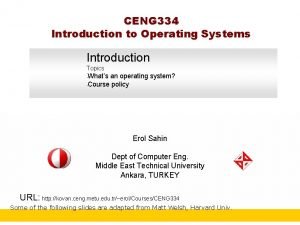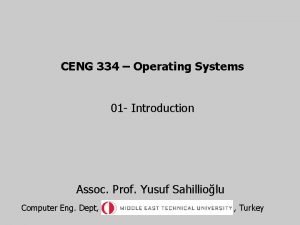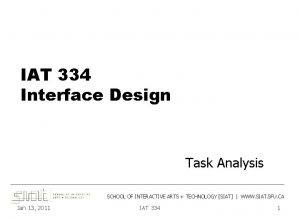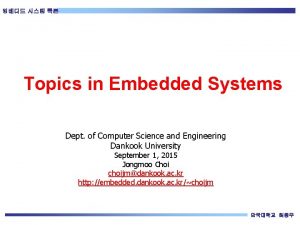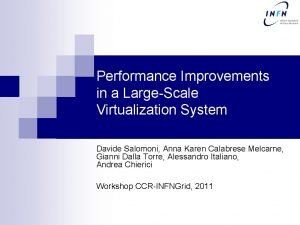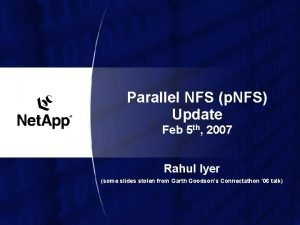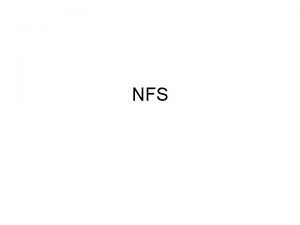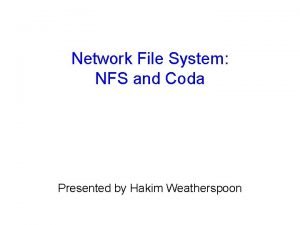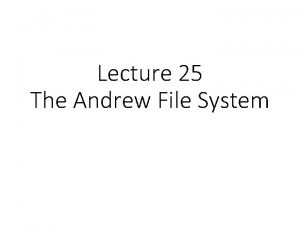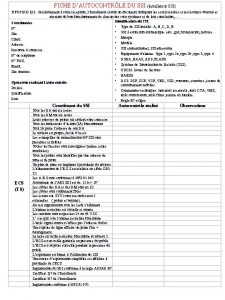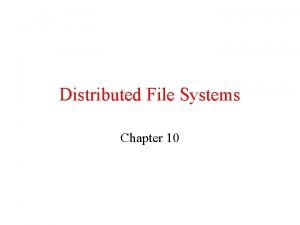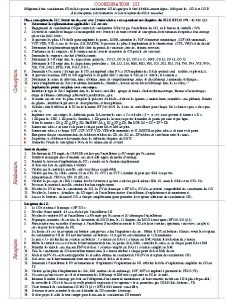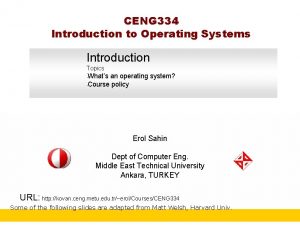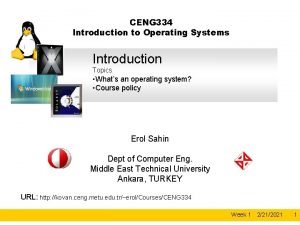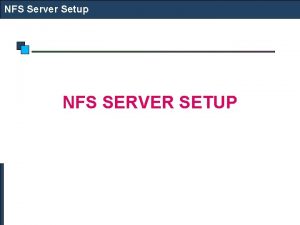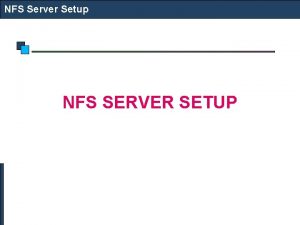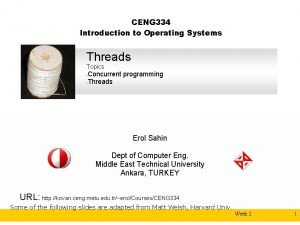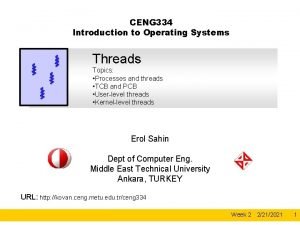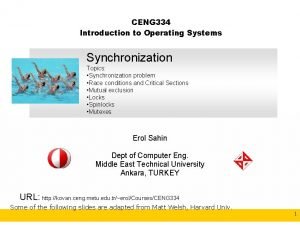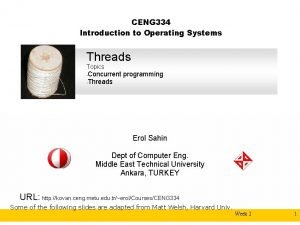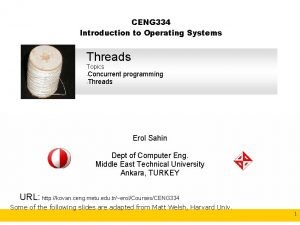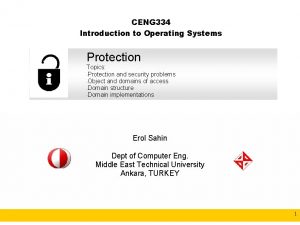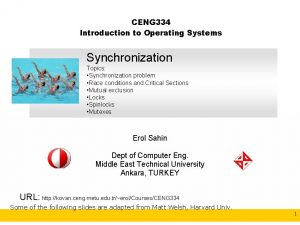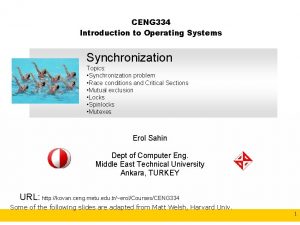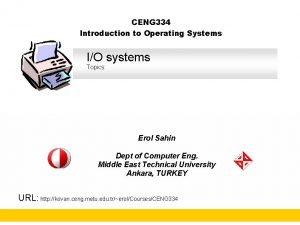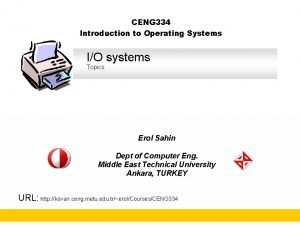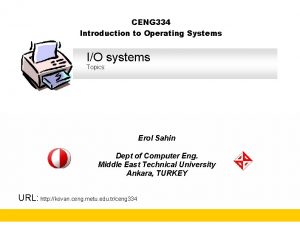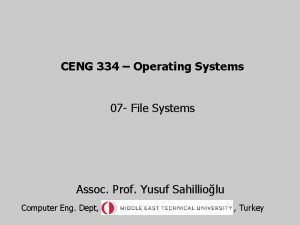CENG 334 Introduction to Operating Systems NFS Topics

















![NLM Example Client A, foo[0. . . 512] Server Client B © 2006 Matt NLM Example Client A, foo[0. . . 512] Server Client B © 2006 Matt](https://slidetodoc.com/presentation_image/a242585f11e458bf80cfe9ccef1e089f/image-18.jpg)
![NLM Example Client A, foo[0. . . 512] Server Client B © 2006 Matt NLM Example Client A, foo[0. . . 512] Server Client B © 2006 Matt](https://slidetodoc.com/presentation_image/a242585f11e458bf80cfe9ccef1e089f/image-19.jpg)
![NLM Example Client A, foo[0. . . 512] Server Client B © 2006 Matt NLM Example Client A, foo[0. . . 512] Server Client B © 2006 Matt](https://slidetodoc.com/presentation_image/a242585f11e458bf80cfe9ccef1e089f/image-20.jpg)
- Slides: 20

CENG 334 Introduction to Operating Systems NFS Topics: Erol Sahin Dept of Computer Eng. Middle East Technical University Ankara, TURKEY

Today: NFS and RAID NFS allows a system to access files over a network One of many distributed file systems Extremely successful and widely used You use NFS on all of your shared files on the FAS and EECS machines RAID: Redundant Arrays of Inexpensive Disks Idea: Make file storage more robust by replicating data across multiple disks Developed at Berkeley in late 80's Now a multibillion-dollar industry © 2006 Matt Welsh – Harvard University 2

NFS Challenges Development of LANs made it really attractive to provide shared file systems to all machines on a network Login to any machine and see the same set of files Install software on a single server that all machines can run Let users collaborate on shared set of files (before CVS!) Why might this be hard to do? ? ? © 2006 Matt Welsh – Harvard University 3

NFS Challenges Development of LANs made it really attractive to provide shared file systems to all machines on a network Login to any machine and see the same set of files Install software on a single server that all machines can run Let users collaborate on shared set of files (before CVS!) Some challenges: Clients and servers might be running different OS Clients and servers might be using different CPU architecture with differing byte ordering (endianess) Client or server might crash independently of each other Must be easy to recover from crashes Potentially very large number of client machines on a network Different users might be trying to modify a shared file at the same time Transparency: Allow user programs to access remote files just like local files No special libraries, recompilation, etc. © 2006 Matt Welsh – Harvard University 4

Three Independent File Systems © 2006 Matt Welsh – Harvard University 5

Mounting in NFS Mounts Cascading mounts a) mount S 1: /usr/shared over U: /usr/local b)mount S 2: /usr/dir 2 over U: /usr/local/dir 1 which is already mounted from S 1 © 2006 Matt Welsh – Harvard University 6

NFS Overview NFS was developed by Sun Microsystems in the mid-80 s Networked machines at the time were predominantly UNIX-based workstations Various vendors: Sun, DEC, IBM, etc. Different CPU architectures and OS implementations But, all used UNIX filesystem structure and semantics NFS is based on Remote Procedure Call (RPC) Allows a client machine to invoke a function on a server machine, over a network Client sends a message with the function arguments Server replies with a message with the return value. External Data Representation (XDR) to represent data types Canonical network representation for ints, longs, byte arrays, etc. Clients and servers must translate parameters and return values of RPC calls into XDR before shipping on the network Otherwise, a little-endian machine and a big-endian machine would disagree on what is meant by the stream of bytes “fe 07 89 da” interpreted as an “int” © 2006 Matt Welsh – Harvard University 7

NFS Design Client Server Client application Kernel VFS Layer ISO 9660 FS ext 3 fs Kernel VFS Layer NFS server RPC/XDR ext 3 fs Network stack Network © 2006 Matt Welsh – Harvard University 8

Stateless Protocol The NFS protocol is stateless The server maintains no information about individual clients! This means that NFS does not support any notion of “opening” or “closing” files Each client simply issues read and write requests specifying the file, offset in the file, and the requested size Advantages? Disadvantages? © 2006 Matt Welsh – Harvard University 9

Stateless Protocol The NFS protocol is stateless The server maintains no information about individual clients! This means that NFS does not support any notion of “opening” or “closing” files Each client simply issues read and write requests specifying the file, offset in the file, and the requested size Advantages: Server doesn't need to keep track of open/close status of files Server doesn't need to keep track of “file offset” for each client's open files Clients do this themselves Server doesn't have to do anything to recover from a crash! Clients simply retry NFS operations until the server comes back up Disadvantages: Server doesn't keep track of concurrent access to same file Multiple clients might be modifying a file at the same time NFS does not provide any consistency guarantees!!! However, there is a separate locking protocol – discussed later © 2006 Matt Welsh – Harvard University 10

NFS Protocol Overview mount() returns filehandle for root of filesystem Actually a separate protocol from NFS. . . lookup(dir-handle, filename) returns filehandle, attribs Returns unique file handle for a given file File handle used in subsequent read/write/etc. calls create(dir-handle, filename, attributes) returns filehandle remove(dir-handle, filename) returns status getattr(filehandle) returns attribs Returns attributes of the file, e. g. , permissions, owner, group ID, size, access time, lastmodified time setattr(filehandle, attribs) returns attribs read(filehandle, offset, size) returns attribs, data write(filehandle, offset, count, data) returns attribs © 2006 Matt Welsh – Harvard University 11

Example What happens if we do “/bin/cat testfile” ? 140. 247. 60. 36. 031 e 140. 247. 50. 252. 0801 U C 3 cd 9 d 450 a 3 lookup fh 0013 eef 90000001 b 0000 name "testfile" euid 813 b egid 186 c con = 146 len = 174 140. 247. 50. 252. 0801 140. 247. 60. 36. 031 e U R 3 cd 9 d 450 a 3 lookup OK fh 0013 eef 90000002 a 0000 ftype 1 mode 180 nlink 1 uid 813 b gid 186 c size 1 aca used 2000 rdev 2 0 fsid 13 eef 9 fileid eef 9002 a atime 1082215906. 000000 mtime 1082215906. 000580 ctime 1082215906. 000580 status=0 pl = 192 con = 70 len = 262 140. 247. 60. 36. 031 e 140. 247. 50. 252. 0801 U C 3 ce 9 d 450 a 6 read fh 0013 eef 90000002 a 0000 off 0 count 2000 euid 813 b egid 186 c 140. 247. 50. 252. 0801 140. 247. 60. 36. 031 e U R 3 ce 9 d 450 a 6 read OK ftype 1 mode 180 nlink 1 uid 813 b gid 186 c size 1 aca used 2000 rdev 2 0 fsid 13 eef 9 fileid eef 9002 a atime 1082215906. 000000 mtime 1082215906. 000580 count aca © 2006 Matt Welsh – Harvard University 12

NFS Caching NFS clients are responsible for caching recently-accessed data Remember: the server is stateless! The NFS protocol does not require that clients cache data. . . But, it provides support allowing a range of client-side caching techniques This is accomplished through the getattr() call Returns size, permissions, and last-modified time of file This can tell a client whether a file has changed since it last read it Read/write calls also return attributes so client can tell if object was modified since the last getattr() call How often does the client use getattr()? © 2006 Matt Welsh – Harvard University 13

NFS Caching NFS clients are responsible for caching recently-accessed data Remember: the server is stateless! The NFS protocol does not require that clients cache data. . . But, it provides support allowing a range of client-side caching techniques This is accomplished through the getattr() call Returns size, permissions, and last-modified time of file This can tell a client whether a file has changed since it last read it Read/write calls also return attributes so client can tell if object was modified since the last getattr() call How often does the client use getattr()? Whenever the file is accessed? Could lead to a lot of getattr calls! Only if the file has not been accessed for some time? e. g. , If the file has not been accessed in 30 sec? Different OS's implement this differently! © 2006 Matt Welsh – Harvard University 14

NFS Locking NFS does not prevent multiple clients from modifying a file simultaneously Clearly, this can be a Bad Thing for some applications. . . Solution: Network Lock Manager (NLM) protocol Works alongside NFS to provide file locking NFS itself does not know anything about locks Clients have to use NLM “voluntarily” to avoid stomping on each other NLM has to be stateful Why? © 2006 Matt Welsh – Harvard University 15

NLM Protocol NLM server has to keep track of locks held by clients If the NLM server crashes. . . All locks are released BUT. . . clients can reestablish locks during a “grace period” after the server recovers No new locks are granted during the grace period Server has to remember which locks were previously held by clients If an NLM client crashes. . . The server is notified when the client recovers and releases all of its locks What happens if a client crashes and does not come back up for a while? Servers and clients must be notified when they crash and recover This is done with the simple “Network Status Monitor” (NSM) protocol Essentially, send a notification to the other host when you reboot © 2006 Matt Welsh – Harvard University 16

NLM Example Client A Server Client B © 2006 Matt Welsh – Harvard University 17
![NLM Example Client A foo0 512 Server Client B 2006 Matt NLM Example Client A, foo[0. . . 512] Server Client B © 2006 Matt](https://slidetodoc.com/presentation_image/a242585f11e458bf80cfe9ccef1e089f/image-18.jpg)
NLM Example Client A, foo[0. . . 512] Server Client B © 2006 Matt Welsh – Harvard University 18
![NLM Example Client A foo0 512 Server Client B 2006 Matt NLM Example Client A, foo[0. . . 512] Server Client B © 2006 Matt](https://slidetodoc.com/presentation_image/a242585f11e458bf80cfe9ccef1e089f/image-19.jpg)
NLM Example Client A, foo[0. . . 512] Server Client B © 2006 Matt Welsh – Harvard University 19
![NLM Example Client A foo0 512 Server Client B 2006 Matt NLM Example Client A, foo[0. . . 512] Server Client B © 2006 Matt](https://slidetodoc.com/presentation_image/a242585f11e458bf80cfe9ccef1e089f/image-20.jpg)
NLM Example Client A, foo[0. . . 512] Server Client B © 2006 Matt Welsh – Harvard University 20
 Ceng334
Ceng334 Ceng 334
Ceng 334 Iat 334
Iat 334 Iat 334
Iat 334 334.edb. hkedcity. net/curriculum
334.edb. hkedcity. net/curriculum Love story 334
Love story 334 Iat 102
Iat 102 8663392432
8663392432 I/o device management in operating system
I/o device management in operating system Embedded systems topics for presentation
Embedded systems topics for presentation Corrected reticulocyte count
Corrected reticulocyte count Normal reticulocyte count
Normal reticulocyte count Sshfs performance tuning
Sshfs performance tuning Sshfs vs nfs
Sshfs vs nfs Nfs p
Nfs p Sun nfs architecture
Sun nfs architecture How does a coda work
How does a coda work Nfs architecture
Nfs architecture Modele fiche autocontrole ssi
Modele fiche autocontrole ssi Network file system architecture
Network file system architecture Nf s 61 970
Nf s 61 970
